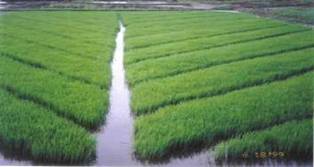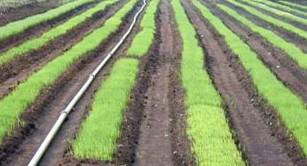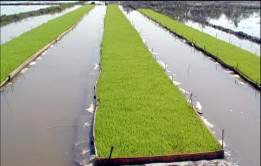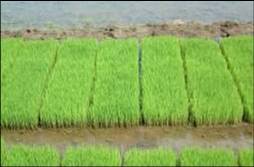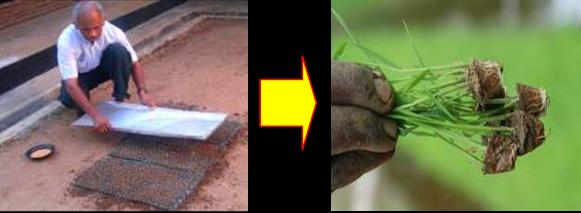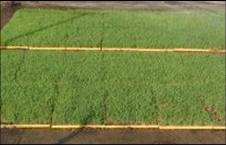|
|
|
Planting the rice |
|
||
|
|
|
|
|
||
|
|
|
Nursery systems |
|
||
|
|
|
|
|
||
|
|
|
Describe the different kinds of nurseries |
|
||
Your nursery depends on water, labor, land etc. |
|
What is a seedling nursery?
If we use the transplanting method rather than the direct seeding method for crop establishment, we need to produce seedlings. These seedlings are produced in a nursery.
Seedling nurseries use 15 to 20% of the total farming area. In preparing the nursery seedbed, the surface needs to be level, free of weeds, and well drained. Low rates of nitrogen and phosphate fertilizer can be applied to the nursery.
Usually seeding rates vary from 400 to 800 kg per hectare of nursery depending on locality, soil type, and seed quality.
Transplanting seedlings. The nursery is in the background.
Different nursery systems
The choice of a particular nursery system depends on the availability of water, labor, land and agricultural implements.
There are 4 nursery systems for transplanting:
|
|
||
|
|
|
1. Wet-Bed Method
The wet-bed nursery is mainly used in areas where there is enough water. Pre-germinated seeds are broadcast on a soil that is thoroughly puddled and leveled. Drainage canals for proper removal of water must be constructed. Addition of organic manure (decomposed) and small amount of inorganic fertilizer as basal dressing will increase easiness of uprooting of seedlings and seedling vigour.
Total seed bed area is about 1/10 of the area to be transplanted and about 40 kg of seed are required to transplant 1 hectare.
The best seedling age for transplanting is about 15-21 days.
Nurseries should be free from weeds, any pest or disease incidence and nutrient deficiencies. If such conditions occur it must be treated at the nursery level.
|
|
||
Different varieties need a different moment of transplanting |
|
2. Dry-bed method
The nursery is prepared in dry soil conditions. Seed beds of convenient dimensions are prepared by raising the soil to a height of about 5-10 cm. A layer of half burned paddy husk could be distributed on the nursery bed to facilitate uprooting.
The site should be free of shade and with adequate irrigation facilities. Total seed bed area is also about 1/10 of the area to be transplanted but about 80 kg of seed are required to transplant 1 hectare (germination is lower). Uprooting of seedlings should be done between 15 - 21 days after germination. Nursery should be maintain without any moisture stress. A basal fertilizer mixture can be applied and incorporated between rows if the soil nutrient supply is low.
The advantage of the dry-bed method is that seedlings are short and strong, with a longer root system compared with the wet-bed method. The seedlings can be raised even during periods of heavy rains.
A disadvantage is however that roots may get damaged during pulling. Seedlings of upland nurseries may also get infected with blast and are more prone to pests such as rodents etc.
|
|
||
|
|
|
3. Dapog method (mats)
Dapog nurseries can be located anywhere on a flat firm surface but water supply/control should be very reliable. The area needed is about 100 m2/ha or 1% of the transplantable land which is much smaller than conventional nurseries.
The dapog or mat method
Another advantage of the "dapog" over wet/dry-bed nurseries is that the cost of uprooting of seedling is minimal. But, because the seedlings are small, transplanting can be more difficult. Very young seedlings from dapog nurseries suffer less from the transplanting shock compared with other nurseries, thus the seedlings are more suitable for short duration varieties. Irrigation is obligatory to prevent water stress.
Some dapog methods:
The modified mat nursery This technology establishes seedlings in a layer of soil mix, arranged on a firm surface. It uses less land and requires fewer seeds and inputs, such as fertilizer and water, reducing nursery costs by up to 50%.
|
|
||
|
|
|
A bubble tray nursery The bubble tray nursery is a good system to develop 12-15 day old seedlings with "root balls". The seedlings are raised on plastic trays of 59 cm by 34 cm with 434 embedded holes. You will need 750 trays per hectare of paddy.
In a bubble tray nursery plastic "sheets" with bubble are used
"Bubble tray seedlings" can also be broadcasted
|
|
||
|
|
|
4. Seedling boxes for mechanical transplanting
Mechanized transplanting requires techniques that are different from hand transplanting. Usually seedling boxes are used that are adapted to the type of transplanter. In a seedling box, seedlings are grown on a thin layer of soil in 30 cm x 60 cm trays. In some instances, seedlings are grown on larger areas and then cut into rectangular strips (mats of seedlings) that fit into the planting trays of the transplanter.
Seedling boxes for mechanical transplanting |
|
||
Go online for more information |
|
For more information on Crop Establishment, please visit: http://www.knowledgebank.irri.org/PlantEstablish/WebHelp/default.htm |
|
||
Next lesson |
|
This ends our lesson on planting. Next we will describe the concept of water management in rice. |
|
||

![obj[1]](obj_1_.gif)

